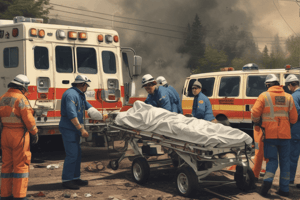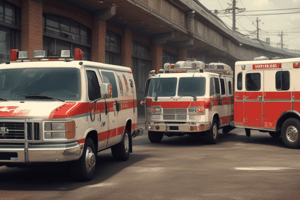Podcast
Questions and Answers
What is the primary characteristic of mass casualty incidents?
What is the primary characteristic of mass casualty incidents?
- They occur frequently in urban areas
- They overwhelm local resources (correct)
- They involve multiple types of accidents
- They are always caused by natural disasters
Which of the following is an example of a mass casualty incident?
Which of the following is an example of a mass casualty incident?
- House fire with one fatality
- Power outage in a city
- Single-car accident
- Building collapse (correct)
What is the role of first responders in mass casualty incidents?
What is the role of first responders in mass casualty incidents?
- Conduct medical transportation for survivors
- Provide emotional support to survivors
- Manage the CERT volunteers
- Secure the area for law enforcement investigations (correct)
What is the main responsibility of CERT volunteers in mass casualty incidents?
What is the main responsibility of CERT volunteers in mass casualty incidents?
What action should be taken by first responders to manage survivors with minor injuries in a mass casualty incident?
What action should be taken by first responders to manage survivors with minor injuries in a mass casualty incident?
What is the purpose of conducting a scene size-up and set-up in a mass casualty incident?
What is the purpose of conducting a scene size-up and set-up in a mass casualty incident?
What does managing medical transportation for survivors involve in mass casualty incidents?
What does managing medical transportation for survivors involve in mass casualty incidents?
What is the role of CERT volunteers in securing the area during mass casualty incidents?
What is the role of CERT volunteers in securing the area during mass casualty incidents?
During triage, victims are evaluated and sorted by the urgency of the treatment needed based on:
During triage, victims are evaluated and sorted by the urgency of the treatment needed based on:
What does the 'Immediate' (I) category represent in triage?
What does the 'Immediate' (I) category represent in triage?
In a disaster environment, what is the first step in the triage process?
In a disaster environment, what is the first step in the triage process?
What action should be taken if a victim does not respond to a simple command during the triage process?
What action should be taken if a victim does not respond to a simple command during the triage process?
What is the purpose of documenting triage results during a disaster?
What is the purpose of documenting triage results during a disaster?
What is a common pitfall to avoid during triage in a disaster environment?
What is a common pitfall to avoid during triage in a disaster environment?
What is the significance of conducting voice triage in a disaster environment?
What is the significance of conducting voice triage in a disaster environment?
Why is CPR not performed when there are many more victims than rescuers?
Why is CPR not performed when there are many more victims than rescuers?
What does the 'Delayed' (D) category represent in triage?
What does the 'Delayed' (D) category represent in triage?
What is the first task of a CERT volunteer when dispatched to the scene or located nearby?
What is the first task of a CERT volunteer when dispatched to the scene or located nearby?
What is the main purpose of disaster medical operations triage/assessment?
What is the main purpose of disaster medical operations triage/assessment?
What are the three main methods for controlling bleeding?
What are the three main methods for controlling bleeding?
What is the most common airway obstruction in emergency medicine?
What is the most common airway obstruction in emergency medicine?
Why should victims suffering from shock NOT eat or drink anything?
Why should victims suffering from shock NOT eat or drink anything?
What is the main priority of medical operations when attending to potential 'killers' in emergency medicine?
What is the main priority of medical operations when attending to potential 'killers' in emergency medicine?
What are the signs of shock that CERT members should look for?
What are the signs of shock that CERT members should look for?
Flashcards
Mass Casualty Incident (MCI)
Mass Casualty Incident (MCI)
An event with a large number of casualties exceeding available medical resources.
First Responders' Role
First Responders' Role
Assess scene, provide initial care, and evacuate critically injured.
CERT Volunteers' Role
CERT Volunteers' Role
Assist first responders, secure area, support emergency management.
Survivor Management
Survivor Management
Signup and view all the flashcards
Scene Size-Up
Scene Size-Up
Signup and view all the flashcards
Area Security
Area Security
Signup and view all the flashcards
Triage Categories
Triage Categories
Signup and view all the flashcards
Immediate (I) Triage
Immediate (I) Triage
Signup and view all the flashcards
Delayed (D) Triage
Delayed (D) Triage
Signup and view all the flashcards
Triage First Step
Triage First Step
Signup and view all the flashcards
Voice Triage
Voice Triage
Signup and view all the flashcards
CPR in MCIs
CPR in MCIs
Signup and view all the flashcards
Bleeding Control Methods
Bleeding Control Methods
Signup and view all the flashcards
Airway Obstruction
Airway Obstruction
Signup and view all the flashcards
Shock Management - Restrictions
Shock Management - Restrictions
Signup and view all the flashcards
Medical Operations Priorities
Medical Operations Priorities
Signup and view all the flashcards
Shock Signs
Shock Signs
Signup and view all the flashcards
Triage Pitfalls
Triage Pitfalls
Signup and view all the flashcards
Study Notes
Mass Casualty Incidents
- Primary characteristic is the overwhelming number of casualties that exceeds the immediate medical resources available.
- Example includes natural disasters, terrorist attacks, or major accidents resulting in multiple injuries.
Role of Responders and Volunteers
- First responders assess the scene, provide initial care, and evacuate critically injured victims.
- CERT (Community Emergency Response Team) volunteers assist in providing support, securing the area, and facilitating emergency management.
Management of Survivors
- First responders prioritize and manage survivors with minor injuries by triaging and ensuring they receive appropriate care as resources allow.
- Documenting triage results is crucial for tracking patient needs and ensuring an organized response.
Scene Size-Up and Setup
- Conducting a scene size-up helps assess hazards, number of victims, and resource needs; this helps in planning an effective response.
- Securing the area is essential to prevent further injury and maintain an organized response to the incident.
Triage Procedures
- Victims are sorted based on urgency: Immediate (I), Delayed (D), and Minor injuries.
- The Immediate category indicates patients who need urgent care to survive; these patients require immediate attention.
- The first step in triage is evaluating victims for responsiveness and vital signs.
Triage Actions and Considerations
- If a victim does not respond to a simple command, they may be labeled as Immediate due to potential life-threatening conditions.
- Avoiding pitfall during triage includes not getting overly focused on one victim at the expense of others in a chaotic environment.
Triage Techniques
- Voice triage engages victims by calling for them, helping assess their response level quickly.
- CPR is not performed in situations with overwhelming victims because resources need to be allocated to those with a higher chance of survival.
Bleeding Control and Shock Management
- The three main methods for controlling bleeding are direct pressure, elevation, and applying a tourniquet.
- The most common airway obstruction is typically a foreign object or swelling, requiring immediate attention.
- Victims in shock should not eat or drink since this can complicate medical management.
Key Concerns During Medical Operations
- Medical operations prioritize addressing 'killers'—conditions or injuries with the highest risk of death.
- Signs of shock include pale skin, rapid pulse, weakness, and confusion—indicators that CERT members must recognize urgently.
Studying That Suits You
Use AI to generate personalized quizzes and flashcards to suit your learning preferences.




